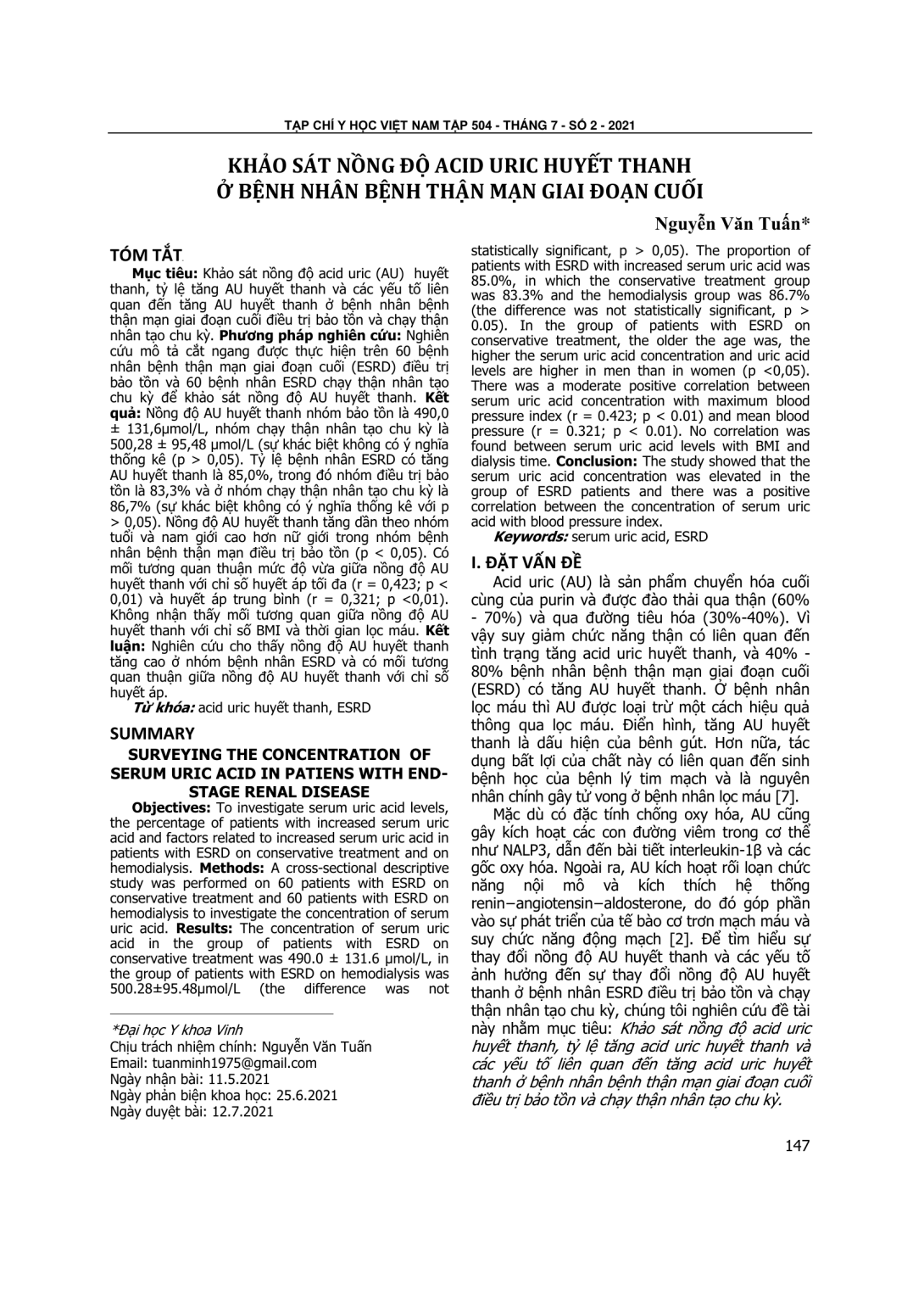
Khảo sát nồng độ acid uric (AU) huyết thanh, tỷ lệ tăng AU huyết thanh và các yếu tố liên quan đến tăng AU huyết thanh ở bệnh nhân bệnh thận mạn giai đoạn cuối điều trị bảo tồn và chạy thận nhân tạo chu kỳ. Phương pháp nghiên cứu: Nghiên cứu mô tả cắt ngang được thực hiện trên 60 bệnh nhân bệnh thận mạn giai đoạn cuối (ESRD) điều trị bảo tồn và 60 bệnh nhân ESRD chạy thận nhân tạo chu kỳ để khảo sát nồng độ AU huyết thanh. Kết quả: Nồng độ AU huyết thanh nhóm bảo tồn là 490,0 ± 131,6µmol/L, nhóm chạy thận nhân tạo chu kỳ là 500,28 ± 95,48 µmol/L (sự khác biệt không có ý nghĩa thống kê (p > 0,05). Tỷ lệ bệnh nhân ESRD có tăng AU huyết thanh là 85,0%, trong đó nhóm điều trị bảo tồn là 83,3% và ở nhóm chạy thận nhân tạo chu kỳ là 86,7% (sự khác biệt không có ý nghĩa thống kê với p > 0,05). Nồng độ AU huyết thanh tăng dần theo nhóm tuổi và nam giới cao hơn nữ giới trong nhóm bệnh nhân bệnh thận mạn điều trị bảo tồn (p < 0,05). Có mối tương quan thuận mức độ vừa giữa nồng độ AU huyết thanh với chỉ số huyết áp tối đa (r = 0,423; p < 0,01) và huyết áp trung bình (r = 0,321; p <0,01). Không nhận thấy mối tương quan giữa nồng độ AU huyết thanh với chỉ số BMI và thời gian lọc máu. Kết luận: Nghiên cứu cho thấy nồng độ AU huyết thanh tăng cao ở nhóm bệnh nhân ESRD và có mối tương quan thuận giữa nồng độ AU huyết thanh với chỉ số huyết áp.
To investigate serum uric acid levels, the percentage of patients with increased serum uric acid and factors related to increased serum uric acid in patients with ESRD on conservative treatment and on hemodialysis. Methods: A cross-sectional descriptive study was performed on 60 patients with ESRD on conservative treatment and 60 patients with ESRD on hemodialysis to investigate the concentration of serum uric acid. Results: The concentration of serum uric acid in the group of patients with ESRD on conservative treatment was 490.0 ± 131.6 µmol/L, in the group of patients with ESRD on hemodialysis was 500.28±95.48µmol/L (the difference was not statistically significant, p > 0,05). The proportion of patients with ESRD with increased serum uric acid was 85.0%, in which the conservative treatment group was 83.3% and the hemodialysis group was 86.7% (the difference was not statistically significant, p > 0.05). In the group of patients with ESRD on conservative treatment, the older the age was, the higher the serum uric acid concentration and uric acid levels are higher in men than in women (p <0,05). There was a moderate positive correlation between serum uric acid concentration with maximum blood pressure index (r = 0.423; p < 0.01) and mean blood pressure (r = 0.321; p < 0.01). No correlation was found between serum uric acid levels with BMI and dialysis time. Conclusion: The study showed that the serum uric acid concentration was elevated in the group of ESRD patients and there was a positive correlation between the concentration of serum uric acid with blood pressure index.
- Đăng nhập để gửi ý kiến
